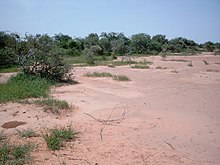Tiger bush
The tiger bush is a form of vegetation that only occurs under certain soil and climatic conditions. Stripes of dense vegetation follow strips with no vegetation. The term goes back to Albert Clos-Arceduc, who first wrote about brousse tigrée in 1956 .
Tiger bush is known from East Africa , the Sahel , Australia , the USA and Mexico . It occurs where too little rain falls to ensure a closed vegetation cover and a slight slope and surface encrustation of the vegetation-free areas lead to extensive runoff of the precipitation. In this way, the vegetation bands receive significantly more water than would otherwise be available under the same precipitation conditions.
A zone with no vegetation is followed down the slope by a pioneer zone with a high proportion of herbaceous vegetation, the core zone of the vegetation band with dense woody vegetation and finally the senescence zone, in which woody plants die. In the course of time, the vegetation bands migrate up the slope as they grow and die.
Individual evidence
- ↑ Albert Clos-Arceduc: Etude sur photographies aériennes d'une formation végétale sahélienne: la brousse tigrée. In: Bulletin de l'IFAN. n ° special, Dakar 1956, pp. 677-684.
- ↑ V. Deblauwe, N. Barber, P. Couteron, O. Lejeune, J. Bogaert: The global biogeography of semi-arid vegetation periodic patterns. In: Global Ecology and Biogeography. 17, 2008, pp. 715-723.
- ↑ a b V. Deblauwe: modulation of structures de végétation auto-organisées en milieu arid. Dissertation. Univ. Libre de Bruxelles, 2010, OCLC 921616210 .
- ↑ V. d'Herbes, C. Valentin, DJ Tongway, JC Leprun: Banded vegetation patterns and related structures. In: DJ Tongway, C. Valentin, J. Seghieri (Eds.): Banded vegetation patterning in arid and semiarid environments. Springer-Verlag, New York 2001.

